Are you a Quiet Speculation member?
If not, now is a perfect time to join up! Our powerful tools, breaking-news analysis, and exclusive Discord channel will make sure you stay up to date and ahead of the curve.
Yesterday, Eli Shiffrin spoiled Blood Sun, a new card from Rivals of Ixalan. Modernites were quick to give the internet a piece of their mind, with thoughts ranging from the expectant "Wizards squandered an opportunity to nerf Tron" to the meme-level "I don't want to be THAT guy, but this card will probably need a ban." Others pontificated on Sun's applications with drawback-featuring lands producing more than a single mana in their mana ability, especially the Ravnica bouncelands. For my part, I'm confident the card will see Modern play in some capacity.
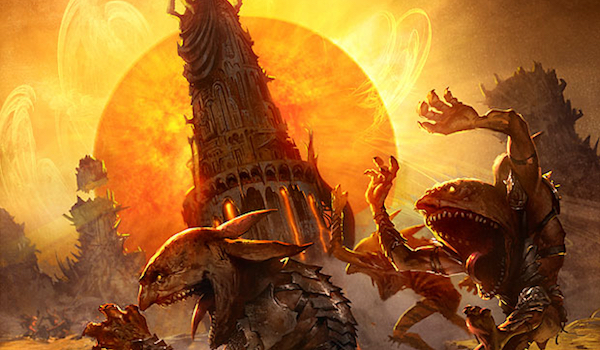
But in what capacity? My mind's also in pieces. Since I'm lucky enough to have this platform available to me, today's article shares the Sun-related ones. We'll look at what the card is and isn't, where it's likeliest to succeed or fail, and what a bounceland deck might actually look like.
Blood Sun Is Not Blood Moon
Let's get this out of the way first. I've already read a torrent of comments comparing Sun to Blood Moon, sometimes even calling it "strictly worse." Others still have called Sun the first "Moon effect" that Tron can run. In truth, Sun isn't a "Moon effect" at all, and it's unfair to compare it to Blood Moon. It's actually closer in design philosophy to Suppression Field. Sun and Moon are fundamentally different from one another in a few ways.
Cheesing Wins
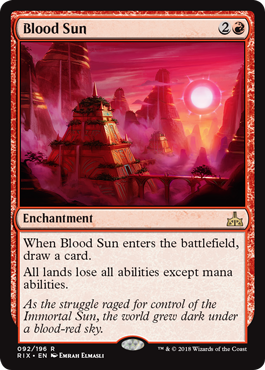 Moon is occasionally played in Modern for help against nonbasic utility lands, sure. But most of the time, It's rushed out as a means of colorscrewing opponents, something Blood Sun by design cannot do. That said, Sun prevents fetchlands from activating, while Moon at least allows them to tap for R.
Moon is occasionally played in Modern for help against nonbasic utility lands, sure. But most of the time, It's rushed out as a means of colorscrewing opponents, something Blood Sun by design cannot do. That said, Sun prevents fetchlands from activating, while Moon at least allows them to tap for R.
While it's true Sun can virtually destroy multiple opposing lands thanks to this interaction, it's far from a reason to play the card, and I doubt anyone will employ Sun for this purpose (other than perhaps those with access to red rituals, which we'll get to). Too much has to go right. Opponents must be on fetchlands in the first place, and have fetchlands they want/need to crack after Sun comes down on turn three (or two in a lucky game); we need to have Sun in hand to cast on the critical turn, as well as not have something more pressing to deal with that turn cycle, like an attacking creature. Modern is a fast format, and tapping out on turn three for an enchantment that doesn't impact the battle zone is as much a liability as it always has been. Moon itself is absent from many top Modern decks in part thanks to this time-off factor. Of course, Sun dismantling fetchlands is bound to come up, but I think it's more realistic to think of this application as a bonus. Pilots will need better reasons to play the card.
Stopping Utility Lands
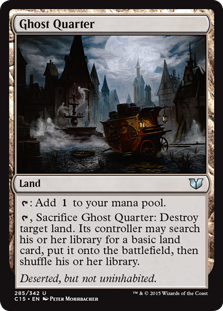 On to Blood Sun's primary purpose, itself a mere tertiary goal for Blood Moon. Modern's incredibly vast card and deck pool ensures it's crawling with utility lands at any given time—among the most popular are Inkmoth Nexus, Ghost Quarter, Celestial Colonnade, and Valakut, the Molten Pinnacle.
On to Blood Sun's primary purpose, itself a mere tertiary goal for Blood Moon. Modern's incredibly vast card and deck pool ensures it's crawling with utility lands at any given time—among the most popular are Inkmoth Nexus, Ghost Quarter, Celestial Colonnade, and Valakut, the Molten Pinnacle.
While Blood Moon also stops utility lands, accommodating it requires a significant deckbuilding tax on players: they mustn't rely on utility lands themselves, and need to reliably extract basic lands from their decks. Sun's cost is less demanding on some fronts, and more on others: pilots should stay away from fetch and utility lands, mostly just running lands that tap for mana. But most decks that don't play fetches are full of utility lands (Hatebears) or otherwise could never afford to splash Sun, even with tweaks (Humans). The result is that very few existing decks can tech Sun at all.
Cantripping
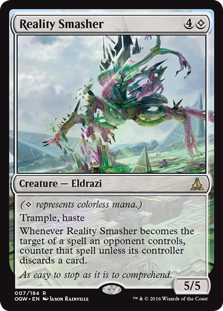 I liken "draw a card" on a noncreature spell to "haste" on a creature spell. It's a line of text that totally modifies the card's playability, and the best evergreen line of text one could ask for on a spell. So is the case with Blood Sun. Thanks to the cantrip, the decks able to run it can do so at a very low opportunity cost. Draw Sun when opponents have already fetched up their lands, or don't have any utility lands? Sun cycles into another card, and its effect still sticks around for future turns!
I liken "draw a card" on a noncreature spell to "haste" on a creature spell. It's a line of text that totally modifies the card's playability, and the best evergreen line of text one could ask for on a spell. So is the case with Blood Sun. Thanks to the cantrip, the decks able to run it can do so at a very low opportunity cost. Draw Sun when opponents have already fetched up their lands, or don't have any utility lands? Sun cycles into another card, and its effect still sticks around for future turns!
If Blood Moon cantripped, we'd see it in a good deal more decks; one of the card's liabilities is drawing it when opponents have already maneuvered around its effect, leaving it dead in hand. The card's weakness in multiples also deters players from maxing out on it.
Finding a Home
Of course, a cantrip won't magically give a card somewhere to live. Sun may not fit into most Modern decks, but a few can still run it.
- Affinity (likely to prefer Blood Moon in its sideboard)
- Skred Red (also likely to stick with Blood Moon)
- WR Burn (not yet a deck but I can see a fetchless build emerging should it need to; compared to Blood Moon, the cantrip saves Sun here)
- Storm
- Tron
The last two decks are the most obvious homes for Blood Sun, and the ones we'll focus on in the following sections.
Sunny Storm
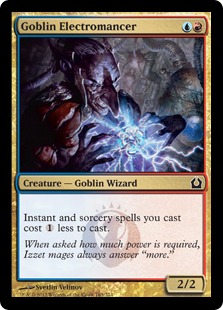 Storm's initial builds post-Baral, Chief of Compliance ran Blood Moon almost by default. After all, it's no secret that a ritual-powered Moon on turn two will lock away a lot of games. As time went on, Storm players realized the constraint early Moons put on their blue mana, as well as the matchup overlap between Moon and high-impact value cards like Pieces of the Puzzle, and began cutting Moon from their sideboards. The result was fetchless Storm, which has yet to come around as the de facto ideal build of the deck, but has none other than Storm savant Caleb Scherer singing its praises no less recently than this very morning.
Storm's initial builds post-Baral, Chief of Compliance ran Blood Moon almost by default. After all, it's no secret that a ritual-powered Moon on turn two will lock away a lot of games. As time went on, Storm players realized the constraint early Moons put on their blue mana, as well as the matchup overlap between Moon and high-impact value cards like Pieces of the Puzzle, and began cutting Moon from their sideboards. The result was fetchless Storm, which has yet to come around as the de facto ideal build of the deck, but has none other than Storm savant Caleb Scherer singing its praises no less recently than this very morning.
A turn-two Blood Sun still does a number on permission-featuring midrange decks like Jeskai Tempo, but without cramping Storm's mana. On the contrary, Sun improves Spirebluff Canal and Steam Vents, which now enter the battlefield untapped for free. Another huge draw to the card is the cantrip; in mana-heavy combo situations, Storm can even cast Sun for another draw and add to the Storm count.
Sunny Tron
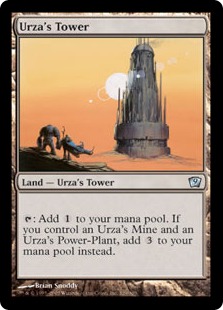 Tron lands still tap for plenty of mana under Blood Sun. But some of the most common ways to hate on big mana strategies become defective. Ghost Quarter, Tectonic Edge, and Field of Ruin are common answers to Tron in this metagame, and Affinity has always posed issues for the archetype, as well—not least because no amount of Pyroclasms will counter lines like "animate Blinkmoth, equip Plating, attack." So has RG Valakut, a big mana deck that, unlike Tron, suffers terribly under Sun; it loses not just its win condition, but its fetchlands, making the card even better than Moon against them!
Tron lands still tap for plenty of mana under Blood Sun. But some of the most common ways to hate on big mana strategies become defective. Ghost Quarter, Tectonic Edge, and Field of Ruin are common answers to Tron in this metagame, and Affinity has always posed issues for the archetype, as well—not least because no amount of Pyroclasms will counter lines like "animate Blinkmoth, equip Plating, attack." So has RG Valakut, a big mana deck that, unlike Tron, suffers terribly under Sun; it loses not just its win condition, but its fetchlands, making the card even better than Moon against them!
In Gx Tron, for which splashing is trivial, Sun solves all these land-based issues at the price of turning off a single Sanctum of Ugin. And it does so while potentially crippling opposing manabases and replacing itself in the hand. I can see Sun becoming a sideboard staple in Tron, but would be surprised if the deck started playing it main—Tron's game-one priority is staying alive until it can win, which means impacting the board or actively ramping.
Forcing a Home
There's also the possibility of building around the aforementioned interaction with Ravnica bouncelands, an interesting proposition since any ensuing deck gets to wield Sun's disruptive dimensions as a bonus. For those not in the know, Sun removes both the "enters the battlefield tapped" ability and the "return a land you control to it's owner's hand" ability from the bouncelands, turning them into actual Sol lands. I've spent about eight hours tinkering with possible builds so far, and have come to a few conclusions about this style of deck:
- Building a manabase around a card like Blood Sun makes the deck horrible when it doesn't open Blood Sun. We should also run Amulet of Vigor to ensure we hit a combo piece, or retain one through disruption. Overloading on these redundant effects also incentivizes us to play "card sinks" like Faithless Looting or Collective Brutality.
- The deck should be three colors so we can run about 10 on-color bouncelands. Fastlands like Blooming Marsh fill out the manabase, as their drawback is lightened by the bouncelands and outright negated under Sun. So is that of City of Brass, which also helps assure the right colors in the early turns.
- Three-drops and five-drops are very important. Threes because turn-one Amulet into turn-two bounceland leads into one, and fives because turn-three Sun into turn-four bounceland leads into one. The best three and five I've found so far, respectively, are Liliana of the Veil and Thragtusk.
- Our haymakers need to catch us up, since we take a turn or two off to set up (i.e. turn-two bounceland, turn-three Sun). Thragtusk is great at this, as are Batterskull and pricey planeswalkers like Elspeth, Sun's Champion or Chandra, Flamecaller.
My favorite build so far is Jund-colored:
Blood Sun Jund, by Jordan Boisvert
Brutality clears the way for haymakers and eats extra lands or combo pieces; Explosives is a hyper-findable and castable piece of disruption; Tarmogoyf is an ideal Plan B should our enablers get Inquisitioned or something (we're going with Goyf-facilitating Method 3 here).
Obviously, this first-draft deck has some major issues. Sometimes, it's got way too much mana and nothing to do with it. It's also particularly soft to the cards Sun may address for other decks, Ghost Quarter, Tectonic Edge, and Field of Ruin; not to mention stuff like Blood Moon, Spreading Seas, and Fulminator Mage that we can't 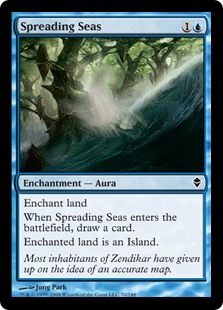 really interact with. But chief among the problems is opener inconsistency: two bouncelands and no "host" land requires an immediate mulligan, making me think I should run more regular lands. But doing so would incentivize heightening the curve, which pushes us further into to Amulet Titan territory—I don't want to build a worse version of that deck.
really interact with. But chief among the problems is opener inconsistency: two bouncelands and no "host" land requires an immediate mulligan, making me think I should run more regular lands. But doing so would incentivize heightening the curve, which pushes us further into to Amulet Titan territory—I don't want to build a worse version of that deck.
I also don't want to build a worse version of Tron. After a day of tweaking, I benched the project, realizing that Tron attains a similar level of ramp for far less effort. Sure, they don't get the incidental disruption of Blood Sun. But they can simply play the card themselves should they decide that's something they want.
Ray of Light
As a raging blizzard wails on Boston, Blood Sun's piercing brightness was just what I needed to pick me back up. After all, nothing takes your mind off subzero temperatures like new spoilers. Here's to more Modern playables and higher temperatures in the coming weeks!




In other words, another entry in Wizards illustrious history of “fixing” cards. They turned a hoser into a combo piece.
What do you mean “in other words?” My article disagrees with this viewpoint on all counts. As stated, I don’t think it’s fair or justified to compare Blood Sun to Blood Moon in this way. Yes, they look and sound alike and share a mana cost. Other than that, they are totally different cards and should be evaluated as such.
As also stated, I have found Sun’s “combo” applications quite lackluster. Would love to see a list if you have found otherwise.
That’s what I meant. They don’t look alike, but they’re cast from the same mold. This is Wizards “fixing” their problem with Blood Moon, turning a non-basic hate card into something else. It’s not really land hate despite appearances, but meant to operate in the same sphere. In my mind, this is Wizards turning Black Lotus into Lions Eye Diamond or Ancestral Recall into Brainstorm. A downgrade in powerlevel that turned it into something else that ended up being far more powerful than expected. You’re right that they’re not the same card or competing for the same space. What I’m saying is this is a transformation that may be as powerful because I got something spicy with Blood Sun in the works for after Bloodbraid month.
Can’t wait to see it!
Now in the spirit of bloodbraid month playing this with the elf and bounce lands seems like a fun time
As they say, the spice must flow.